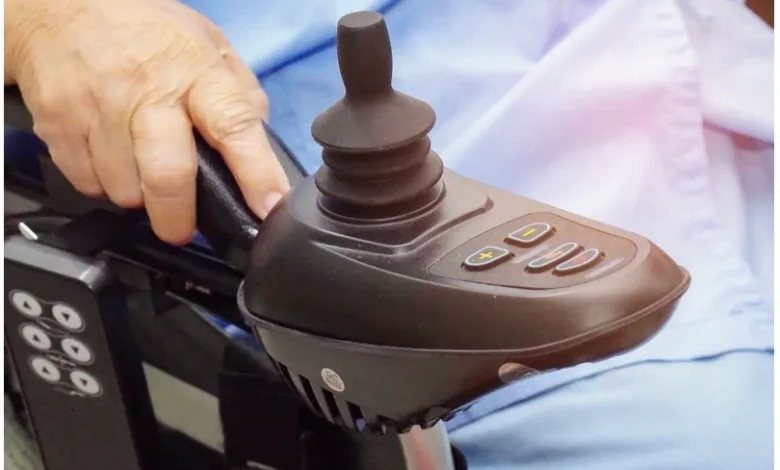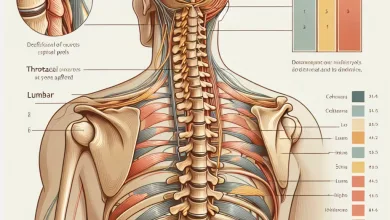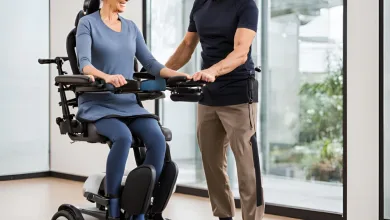Top 8 Power Wheelchair Repairs: Keep Rolling (Literally!)

Table of Contents
Top 8 Power Wheelchair Repairs: Keep Rolling (Literally!)
Keeping Your Power Wheelchair Running Smoothly: Essential Repairs You Need to Know
Our power wheelchairs are lifelines to freedom and independence. They allow us to explore the world, connect with loved ones, and live our lives fully. But like any machine, power wheelchairs require regular maintenance and occasional repairs to keep them functioning smoothly.
Here, we will discuss the top 8 common power wheelchair problems you might encounter. We’ll also discuss the signs and symptoms to watch out for and why it’s crucial to address these issues promptly.
So, whether you’re a seasoned power wheelchair user or a caregiver, this guide will equip you with the necessary knowledge to keep your wheels turning!
1. Battery Blues: When Your Power Source Needs Attention
The battery is the heart and soul of your power wheelchair. It provides the juice that keeps you moving. A failing battery can leave you stranded in the middle of your day.
Signs of a Battery on the Brink:
- Reduced Range: You notice a significant decrease in how far you can travel on a single charge.
- Slow Charging: Charging takes much longer than usual to charge your battery fully.
- Frequent Shutdowns: The power wheelchair unexpectedly shuts down, even when the battery indicator shows a remaining charge.
Why a Timely Fix Matters:
A neglected battery can leave you stranded and damage other electrical components in your wheelchair.
2. Flat Tire Frenzy: Fixing a Flat on Your Power Wheelchair
Just like bicycles and cars, power wheelchairs can get flat tyres. While it might seem minor, a flat tyre can be a safety hazard, especially if it happens while you’re out and about.
Signs of a Flat Tire:
- The wheelchair pulls to one side.
- The tyre feels noticeably softer than usual.
- You hear a scraping sound coming from the tyre.
Why a Speedy Repair is Important:
Riding on a flat tyre can damage the rim and make it more challenging to manoeuvre your wheelchair.
3. Joystick Jitters: When Your Control System Goes on the Fritz
The joystick is your command centre, allowing you to navigate your power wheelchair with ease. A malfunctioning joystick can be frustrating and even dangerous.
Signs of a Joystick in Trouble:
- The joystick becomes unresponsive or moves erratically.
- The wheelchair doesn’t move in the direction you intend.
- Buttons on the joystick become sticky or unresponsive.
Why a Fix is Important:
A faulty joystick can make it difficult or impossible to control your power wheelchair, increasing the risk of accidents.
4. Motor Disorder: When the Engine of Your Power Wheelchair Needs Attention
The motors are the workhorses of your power wheelchair, propelling you forward and backwards. Motor problems can significantly hinder your mobility.
Signs of Motor Disorder:
- The wheelchair moves slower than usual.
- Unusual noises come from the motors when operating.
- The wheelchair struggles to climb inclines.
Why Addressing Motor Issues is Essential:
Neglected motor problems can worsen over time, leading to a complete breakdown and costly repairs.
[Insert royalty-free image of a power wheelchair motor]
Now, let’s explore some repairs that might require a visit to a qualified power wheelchair repair technician.
5. Frightful Flashers: When Warning Signals Fail
Turn signals and brake lights are crucial for safety, ensuring you’re visible to pedestrians and other vehicles.
Signs of Failing Flashers:
- The turn signals don’t blink or illuminate at all.
- The brake lights don’t come on when you apply the brakes.
Why a Fix is Non-Negotiable:
Faulty warning signals put you at risk of accidents. Don’t wait to address this issue!
6. Controller Conundrum: When the Brains of the Operation Need Fixing
The controller is the brain of your power wheelchair, processing signals from the joystick and transmitting them to the motors. A malfunctioning controller can cause a variety of problems.
Signs of a Controller on the Fritz:
- The wheelchair exhibits erratic behaviour, like sudden stops or changes in direction.
- The battery drains quickly, even with a new battery.
- Error messages appear on the controller display.
7. Loose Connections Causing Confusion
Electrical connections are the unseen heroes of your power wheelchair, ensuring smooth communication between various components. Loose or corroded connections can disrupt this communication and cause various issues.
Signs of Loose Connections:
- Intermittent power issues – the wheelchair might start and stop unexpectedly.
- Lights flicker or dim.
- The joystick becomes unresponsive at times.
Why Addressing Connections is Important:
Left unattended, loose connections can damage electrical components and lead to more expensive repairs down the road.
8. Worn-Out Parts: When Time Takes Its Toll
Like any machine, power wheelchairs have parts that experience wear and tear over time. These worn-out parts can affect performance and safety.
Commonly Worn-Out Parts:
- Seat Cushions and Backrests provide comfort and support but can compress and lose effectiveness over time.
- Tyres can wear down from regular use, requiring replacement to ensure proper traction and manoeuvrability.
- Brakes: Brake pads wear down when used and must be replaced to maintain safe stopping power.
Why Regular Maintenance is Key:
Regular power wheelchair maintenance can help identify worn-out parts before they cause significant problems. Proactively replacing these parts can extend the life of your wheelchair and improve your overall driving experience.
Now that we’ve explored the top 8 repairs, let’s address some frequently asked questions.
Power Wheelchair Repair FAQs
- How often should I get my power wheelchair serviced?
The recommended service frequency can vary depending on your wheelchair model and usage. However, most manufacturers recommend a professional service check at least once a year.
- Can I perform any power wheelchair repairs myself?
Some basic maintenance tasks, like checking tyre pressure and cleaning the joystick, can be done at home. However, it’s always best to consult a qualified technician for more complex repairs.
- How much do power wheelchair repairs typically cost?
The cost of repairs can vary depending on the specific problem and the parts required. Getting a quote from a technician before proceeding with any repairs is always a good idea.
- What are some tips for preventing power wheelchair repairs?
Regular maintenance is key! Following the manufacturer’s recommendations for maintenance and using your wheelchair correctly can help prevent many common problems.
- Where can I find a qualified power wheelchair repair technician?
You can ask your doctor or therapist for recommendations. Many wheelchair manufacturers and dealerships also have certified technicians on staff.
Common Power Wheelchair Repairs at a Glance
This table provides a quick reference guide to some of the most common power wheelchair repairs. By familiarizing yourself with the signs and symptoms of these faults, you can take action promptly and keep your power wheelchair running smoothly.
| Fault | Signs & Symptoms | Repair | Importance of Addressing Promptly |
| Battery Blues | Reduced range, slow charging, unexpected shutdowns | Replace battery | Avoids being stranded, protects other electrical components |
| Flat Tire Frenzy | Pulling to one side, soft tire, scraping sound | Patch or replace tire | Prevents rim damage, maintains maneuverability |
| Joystick Jitters | Unresponsive joystick, erratic movement, sticky buttons | Repair or replace joystick | Ensures safe and controlled operation |
| Motor Mayhem | Slower speed, unusual noises, struggles on inclines | Repair or replace motor | Prevents further damage and costly repairs |
| Frightful Flashers | Inoperative turn signals or brake lights | Repair or replace lights | Crucial for safety and visibility |
| Controller Conundrum | Erratic behaviour, rapid battery drain, error messages | Repair or replace controller | Restores proper operation and prevents further issues |
| Loose Connections | Intermittent power, flickering lights, unresponsive joystick | Tighten or replace connections | Prevents damage to electrical components |
| Worn-Out Parts | Flattened seat cushions, worn tires, diminished braking power | Replace worn-out parts | Maintains comfort, safety, and performance |
Conclusion:
By understanding common power wheelchair problems and addressing them promptly, you can keep your mobility device running smoothly and safely. Remember, preventive maintenance is your best friend when it comes to power wheelchair repair. With a bit of care and attention, your power wheelchair will continue to be your trusted companion for many years to come.
With a bit of care and attention, your power wheelchair will continue to be your trusted companion for many years to come. If you have any specific questions about power wheelchair maintenance or repairs, feel free to leave a comment below, and I’ll do my best to help!



